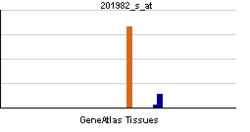Pregnancy-associated plasma protein A
| PAPPA | |||||||||||||||||
|---|---|---|---|---|---|---|---|---|---|---|---|---|---|---|---|---|---|
| Identifiers | |||||||||||||||||
| Aliases | PAPPA, ASBABP2, DIPLA1, IGFBP-4ase, PAPA, PAPP-A, PAPPA1, pappalysin 1 | ||||||||||||||||
| External IDs | OMIM: 176385 MGI: 97479 HomoloGene: 31097 GeneCards: PAPPA | ||||||||||||||||
|
|||||||||||||||||
| RNA expression pattern | |||||||||||||||||
 
|
|||||||||||||||||
| More reference expression data | |||||||||||||||||
| Orthologs | |||||||||||||||||
| Species | Human | Mouse | |||||||||||||||
| Entrez |
|
|
|||||||||||||||
| Ensembl |
|
|
|||||||||||||||
| UniProt |
|
|
|||||||||||||||
| RefSeq (mRNA) |
|
|
|||||||||||||||
| RefSeq (protein) |
|
|
|||||||||||||||
| Location (UCSC) | Chr 9: 116.15 – 116.4 Mb | Chr 4: 65.12 – 65.36 Mb | |||||||||||||||
| PubMed search | |||||||||||||||||
Pappalysin-1, also known as pregnancy-associated plasma protein A, is a protein encoded by the PAPPA gene in humans. PAPPA is a secreted protease whose main substrate is insulin-like growth factor binding proteins. Pappalysin-1 is also used in screening tests for Down syndrome.
This gene encodes a secreted metalloproteinase which cleaves insulin-like growth factor binding proteins (IGFBPs). PAPPA's proteolytic function is activated upon collagen binding. It is thought to be involved in local proliferative processes such as wound healing and bone remodeling. Low plasma level of this protein has been suggested as a biochemical marker for pregnancies with aneuploid fetuses (fetuses with an abnormal number of chromosomes). For example, low PAPPA may be commony seen in prenatal screening for Down syndrome. Low levels may alternatively predict issues with the placenta, resulting in adverse complications such as intrauterine growth restriction, preeclampsia, placental abruption, premature birth, or fetal death.
...
Wikipedia
